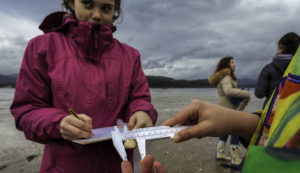Shellfish and Climate Change Research

To view the photo-rich magazine version, click here.
Originally appears in the Summer 2018 issue.
ANTHROPOGENIC CLIMATE change is one of the greatest challenges facing the world today. For this reason, it is essential to make citizens aware of its urgency, following the premise of “think globally, act locally.” Secondary school can act as an effective bridge between science and a local community, so why not carry out field experiences where students can research the local effects of climate change, and then disseminate their conclusions? Following this target, we at Climántica have developed a school-based research project in a shellfish bank in Testal, Galicia, Spain, involving a total of 70 students aged 13 to 17 years old. This shellfish bank is an ideal study site as it has a rich congregation of the common cockle (Cerastoderma edule). This species is commercially harvested here, meaning that it has both ecological and economic significance in the area. Other mollusk species are also ecologically and economically significant in various parts of Europe, Asia, and America, so similar studies can be carried out at many locations.
Below, we have outlined the steps of our study in Testal with hopes that you can replicate a similar study in your region.
Background
In class on the day prior to carrying out data collection in the shellfish bank, students were instructed on the proposed research method, the biology of the focus animal, and how to use the materials needed to conduct the field work.
This content is restricted to subscribers only.
If you are not yet a subscriber, please consider taking out a subscription here.
If you are an existing subscriber, kindly log in or contact us at info@greenteacher.com for more information.





